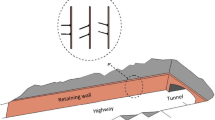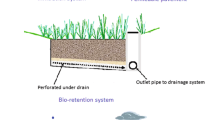Abstract
Since environmental factors at pavement construction sites are usually changed, the behavior of plastic shrinkage cracking, which is a common type of distress in concrete pavement, needs to be assessed to avoid deterioration and apply a more appropriate preventive method. This study evaluates the effects of different ambient temperature (30, 35, and 40 °C), relative humidity of the air (20, 45, and 70%), and wind speed (18, 24, and 30 km/h) on the characteristics of plastic shrinkage cracking distress in concrete pavement that are more practical in terms of inspection. These practical characteristics include temporal characteristics (time of balance of bleeding and evaporation, and time of the start of crackling) and geometric characteristics (mean cracking width, length of cracking, and area of cracking). They were examined in different environmental conditions according to ASTM C1579 standard test method, using an environmental simulator chamber and a digital monitoring approach consisted of digital image analysis. The results showed that practical characteristics are useful in denoting the behavior of plastic shrinkage cracking distress in concrete pavements in different environmental conditions. Each environmental factor has a different significant effect on the behavior of plastic shrinkage cracking distress. The time of balance was the most affected temporal characteristics, which shows higher sensitivity of the bleeding state of concrete pavement to environmental factors. Among geometric characteristics, the area of cracking was changed the most. Different environmental factors also had a more significant effect on the transverse changing of cracking than its longitudinal. The relative humidity had the most effects on the temporal and geometric characteristics, and the effects of temperature and wind speed were close to each other. A significant relationship was observed between the time of balance and the area of cracking, which indicates that the time of balance can be used effectively to predict cracking severity in different environmental conditions.


























Similar content being viewed by others
Notes
The metrological information for this location is for 2020 and can be found in weather information websites such as www.worldweatheronline.com
References
Combrinck, R., Kayondo, M., le Roux, B. D., de Villiers, W. I., & Boshoff, W. P. (2019). Effect of various liquid admixtures on cracking of plastic concrete. Construction and Building Materials, 202, 139–153. https://doi.org/10.1016/j.conbuildmat.2018.12.060
Bertelsen, I. M. G., Ottosen, L. M., & Fischer, G. (2019). Quantitative analysis of the influence of synthetic fibres on plastic shrinkage cracking using digital image correlation. Construction and Building Materials, 199, 124–137. https://doi.org/10.1016/j.conbuildmat.2018.11.268
Bendimerad, A. Z., Rozière, E., & Loukili, A. (2016). Plastic shrinkage and cracking risk of recycled aggregates concrete. Construction and Building Materials, 121, 733–745. https://doi.org/10.1016/j.conbuildmat.2016.06.056
Wyrzykowski, M., Trtik, P., Münch, B., Weiss, J., Vontobel, P., & Lura, P. (2015). Plastic shrinkage of mortars with shrinkage reducing admixture and lightweight aggregates studied by neutron tomography. Cement and Concrete Research, 73, 238–245. https://doi.org/10.1016/j.cemconres.2015.03.013
Juarez, C. A., Fajardo, G., Monroy, S., Duran-Herrera, A., Valdez, P., & Magniont, C. (2015). Comparative study between natural and PVA fibers to reduce plastic shrinkage cracking in cement-based composite. Construction and Building Materials, 91, 164–170. https://doi.org/10.1016/j.conbuildmat.2015.05.028
Combrinck, R., & Boshoff, W. P. (2013). Typical plastic shrinkage cracking behaviour of concrete. Magazine of Concrete Research, 65, 486–493. https://doi.org/10.1680/macr.12.00139
Sivakumar, A., & Santhanam, M. (2007). A quantitative study on the plastic shrinkage cracking in high strength hybrid fibre reinforced concrete. Cement and Concrete Composites, 29, 575–581. https://doi.org/10.1016/j.cemconcomp.2007.03.005
Mora-ruacho, J., Gettu, R., & Aguado, A. (2009). Cement and Concrete Research In fl uence of shrinkage–reducing admixtures on the reduction of plastic shrinkage cracking in concrete. Cement and Concrete Research, 39, 141–146. https://doi.org/10.1016/j.cemconres.2008.11.011
Pelisser, F., Neto, A. B., La Rovere, H. L., & Pinto, R. C. D. A. (2010). Effect of the addition of synthetic fibers to concrete thin slabs on plastic shrinkage cracking. Construction and Building Materials, 24, 2171–2176. https://doi.org/10.1016/j.conbuildmat.2010.04.041
Ghourchian, S., Wyrzykowski, M., Plamondon, M., & Lura, P. (2019). On the mechanism of plastic shrinkage cracking in fresh cementitious materials. Cement and Concrete Research, 115, 251–263. https://doi.org/10.1016/j.cemconres.2018.10.015
Lura, P., Pease, B., Mazzotta, G. B., Rajabipour, F., & Weiss, J. (2007). Influence of shrinkage–reducing admixtures on development of plastic shrinkage cracks. ACI Materials Journal, 104, 187. https://doi.org/10.14359/18582
Shahin, M. Y. (2005). Pavement management for airports, roads, and parking lots. New York: Springer.
Ghourchian, S., Wyrzykowski, M., Baquerizo, L., & Lura, P. (2018). Performance of passive methods in plastic shrinkage cracking mitigation. Cement and Concrete Composites, 91, 148–155. https://doi.org/10.1016/j.cemconcomp.2018.05.008
Kayondo, M., Combrinck, R., & Boshoff, W. P. (2019). State-of-the-art review on plastic cracking of concrete. Construction and Building Materials, 225, 886–899. https://doi.org/10.1016/j.conbuildmat.2019.07.197
Slowik, V., Hübner, T., Schmidt, M., & Villmann, B. (2009). Simulation of capillary shrinkage cracking in cement-like materials. Cement and Concrete Composites, 31, 461–469. https://doi.org/10.1016/j.cemconcomp.2009.05.004
Branston, J., Das, S., Kenno, S. Y., & Taylor, C. (2016). Influence of basalt fibres on free and restrained plastic shrinkage. Cement and Concrete Composites, 74, 182–190. https://doi.org/10.1016/j.cemconcomp.2016.10.004
Olivier, G., Combrinck, R., Kayondo, M., & Boshoff, W. P. (2018). Combined effect of nano-silica, super absorbent polymers, and synthetic fibres on plastic shrinkage cracking in concrete. Construction and Building Materials, 192, 85–98. https://doi.org/10.1016/j.conbuildmat.2018.10.102
Ghourchian, S., Wyrzykowski, M., & Lura, P. (2018). A poromechanics model for plastic shrinkage of fresh cementitious materials. Cement and Concrete Research, 109, 120–132. https://doi.org/10.1016/j.cemconres.2018.04.013
Ghourchian, S., Wyrzykowski, M., & Lura, P. (2017). A practical approach for reducing the risk of plastic shrinkage cracking of concrete. RILEM Tech Lett. https://doi.org/10.21809/rilemtechlett.2017.45
Ghourchian, S., Wyrzykowski, M., & Lura, P. (2016). The bleeding test: A simple method for obtaining the permeability and bulk modulus of fresh concrete. Cement and Concrete Research, 89, 249–256. https://doi.org/10.1016/j.cemconres.2016.08.016
Temitope, J., Combrinck, R., & Peter, W. (2020). Shear rheo-viscoelasticity approach to the plastic cracking of early-age concrete Solid phase. Cement and Concrete Research. https://doi.org/10.1016/j.cemconres.2020.106127
Combrinck, R., & Boshoff, W. P. (2019). Tensile properties of plastic concrete and the influence of temperature and cyclic loading. Cement and Concrete Composites, 97, 300–311. https://doi.org/10.1016/j.cemconcomp.2019.01.002
Combrinck, R., Steyl, L., & Boshoff, W. P. (2018). Interaction between settlement and shrinkage cracking in plastic concrete. Construction and Building Materials, 185, 1–11. https://doi.org/10.1016/j.conbuildmat.2018.07.028
S. Ghourchian, Plastic Shrinkage Cracking in Concrete: From Mechanisms to Mitigation Strategies, ETH Zürich, 2018.
Boshoff, W. P., & Combrinck, R. (2013). Modelling the severity of plastic shrinkage cracking in concrete. Cement and Concrete Research, 48, 34–39. https://doi.org/10.1016/j.cemconres.2013.02.003
Bertelsen, I. M. G., Ottosen, L. M., & Fischer, G. (2020). Influence of fibre characteristics on plastic shrinkage cracking in cement-based materials: A review. Construction and Building Materials, 230, 116769. https://doi.org/10.1016/j.conbuildmat.2019.116769
Zhan, P. M., & He, Z. H. (2019). Application of shrinkage reducing admixture in concrete: A review. Construction and Building Materials, 201, 676–690. https://doi.org/10.1016/j.conbuildmat.2018.12.209
Combrinck, R., Steyl, L., & Boshoff, W. P. (2018). Influence of concrete depth and surface finishing on the cracking of plastic concrete. Construction and Building Materials, 175, 621–628. https://doi.org/10.1016/j.conbuildmat.2018.04.225
Bertelsen, I. M. G., Kragh, C., Cardinaud, G., Ottosen, L. M., & Fischer, G. (2019). Quantification of plastic shrinkage cracking in mortars using digital image correlation. Cement and Concrete Research, 123, 105761. https://doi.org/10.1016/j.cemconres.2019.05.006
Moelich, G. M., & Combrinck, R. (2020). A weather data analysis method to mitigate and prevent plastic shrinkage cracking. Construction and Building Materials, 253, 119066. https://doi.org/10.1016/j.conbuildmat.2020.119066
Liu, J. P., Tian, Q., & Miao, C. W. (2012). Investigation on the plastic shrinkage of cementitious materials under drying conditions: Mechanism and theoretical model. Magazine of Concrete Research, 64, 551–561
Banthia, N., & Gupta, R. (2006). Influence of polypropylene fiber geometry on plastic shrinkage cracking in concrete. Cement and Concrete Research, 36, 1263–1267. https://doi.org/10.1016/j.cemconres.2006.01.010
Senthilkumar, S. R. R., & Natesan, S. C. (2005). Prediction of restrained plastic shrinkage cracking in plain cement concrete. Magazine of Concrete Research, 57, 579–587. https://doi.org/10.1680/macr.2005.57.9.579
Yakoubi, I., & Aggoun, S. (2016). H Ait Aider, H Houari, The influence of bleeding, extra water and superplasticizer on the SCC plastic shrinkage cracking: Case of hot weather. Journal of adhesion science and Technology, 30, 2596–2618. https://doi.org/10.1080/01694243.2016.1189869
Zhao, P., Zsaki, A. M., & Nokken, M. R. (2018). Using digital image correlation to evaluate plastic shrinkage cracking in cement-based materials. Construction and Building Materials, 182, 108–117. https://doi.org/10.1016/j.conbuildmat.2018.05.239
Meyer, D. M., Boshoff, W. P., & Combrinck, R. (2020). Utilising super absorbent polymers as alternative method to test plastic shrinkage cracks in concrete. Construction and Building Materials, 248, 118666
Rasol, M. A., Pérez-Gracia, V., Fernandes, F. M., Pais, J. C., Santos-Assunçao, S., Santos, C., & Sossa, V. (2020). GPR laboratory tests and numerical models to characterize cracks in cement concrete specimens, exemplifying damage in rigid pavement. Measurement, 158, 107662. https://doi.org/10.1016/j.measurement.2020.107662
Diamanti, N., & Redman, D. (2012). Field observations and numerical models of GPR response from vertical pavement cracks. Journal of Applied Geophysics, 81, 106–116. https://doi.org/10.1016/j.jappgeo.2011.09.006
Rasol, M. A., Pérez-Gracia, V., Fernandes, F. M., Pais, J. C., Solla, M., & Santos, C. (2020). NDT assessment of rigid pavement damages with ground penetrating radar: laboratory and field tests. International Journal of Pavement Engineering. https://doi.org/10.1080/10298436.2020.1778692
Kong, W., Wei, Y., Wang, S., Chen, J., & Wang, Y. (2020). Research progress on cement-based materials by X-ray computed tomography. International Journal Pavement Research Technology. https://doi.org/10.1007/s42947-020-0119-8
LS de Salles, R Conway, L Khazanovich, R Barnes, K Hoegh, D da Silva Pereira, T Burnham. Non-destructive ultrasonic evaluation of construction variability effect on concrete pavement performance, International Journal Pavement Research Technology. (2020). Doi: https://doi.org/10.1007/s42947-020-1198-2.
M.A. Rasol, V. Pérez-Gracia, M. Solla, J.C. Pais, F.M. Fernandes, C. Santos, An experimental and numerical approach to combine Ground Penetrating Radar and computational modeling for the identification of early cracking in cement concrete pavements, NDT E Int. 115 (2020). https://doi.org/https://doi.org/10.1016/j.ndteint.2020.102293.
Sirajuddin, M., & Gettu, R. (2018). Plastic shrinkage cracking of concrete incorporating mineral admixtures and its mitigation. Material Structure Construction. https://doi.org/10.1617/s11527-018-1173-4
P. Fontana, S. Pirskawetz, P. Lura, Plastic shrinkage cracking risk of concrete–Evaluation of test methods, in: 7th RILEM Int. Conf. Crack. Pavements, Springer, 2012: pp. 591–600.
Qi, C., Weiss, J., & Olek, J. (2003). Characterization of plastic shrinkage cracking in fiber reinforced concrete using image analysis and a modified Weibull function. Material Structure Construction, 36, 386–395. https://doi.org/10.1617/12686
Acknowledgments
This research did not receive any specific grant from funding agencies in the public, commercial, or not-for-profit sectors. Any opinion, findings and conclusions or recommendation expressed in this work is that of the author(s).
Funding
This research did not receive any specific grant from funding agencies in the public, commercial, or not-for-profit sectors.
Author information
Authors and Affiliations
Contributions
Not applicable.
Corresponding author
Ethics declarations
Conflict of interests
The authors declare that they have no known competing financial interests or personal relationships that could have appeared to influence the work reported in this paper.
Rights and permissions
About this article
Cite this article
Ziari, H., Fazaeli, H., Vaziri Kang Olyaei, S.J. et al. Evaluation of Effects of Temperature, Relative Humidity, and Wind Speed on Practical Characteristics of Plastic Shrinkage Cracking Distress in Concrete Pavement Using a Digital Monitoring Approach. Int. J. Pavement Res. Technol. 15, 138–158 (2022). https://doi.org/10.1007/s42947-021-00016-2
Received:
Revised:
Accepted:
Published:
Issue Date:
DOI: https://doi.org/10.1007/s42947-021-00016-2




